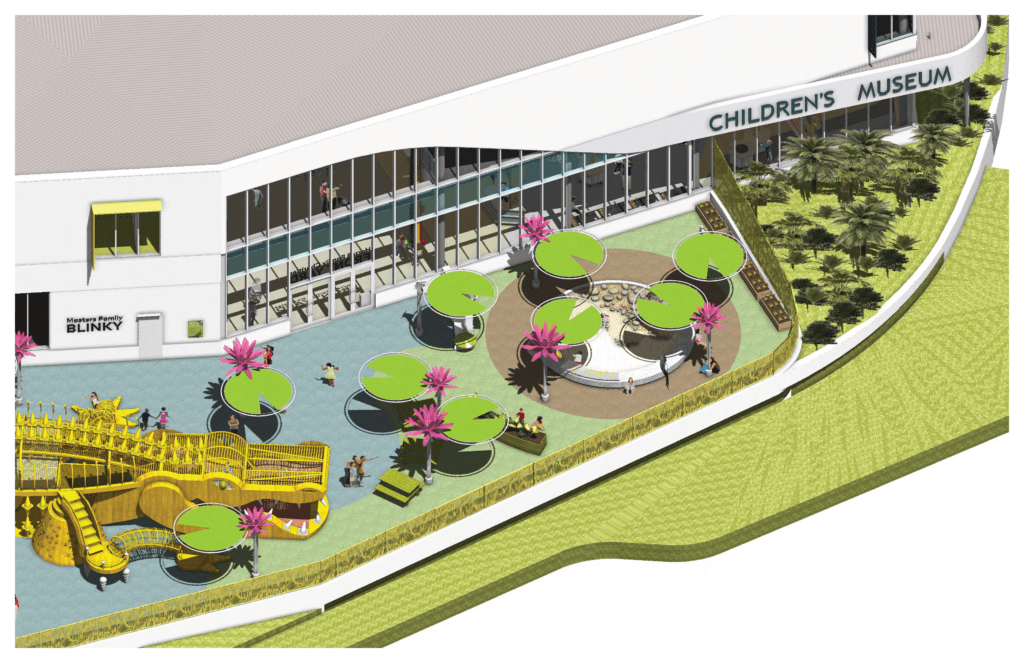Children’s Museum Will Teach About Florida Ecology and Agriculture
by PAUL CATALA
The new Bonnet Springs Park will bring more green and a newfound appreciation for agricultural spaces to the city of Lakeland, but just inside there’s something else that is also creating quite a buzz — the Florida Children’s Museum.
The museum, formerly known as Explorations V Children’s Museum in downtown Lakeland, is creating its new facility to educate children and their parents on the significance of Florida agriculture and wildlands.
The Florida Children’s Museum will have a strong focus on agriculture and outdoors-related exhibits and activities for children, says Kerry Falwell, the museum’s chief executive officer.
It will span 47,800 square feet indoors and outdoors to accommodate an estimated 100,000 visitors each year, double the guests the facility served in downtown Lakeland.
Although Explorations V already had ag-related exhibits such as the popular “O is for Oranges,” a citrus-related section, museum staff wanted to significantly increase agriculture and nature activities and exhibits. Falwell says the museum seeks to demonstrate how the state still has a strong agricultural presence.
“When we were designing the new facility, we really wanted to think about what’s current in agriculture, what’s really driving our economy, and what are the new and emerging areas that we can share with families?” explains Falwell.
The museum is adding themed areas to its building, such as the 3,800-square-feet “Watermelon Seeds” section that teaches guests 6 years old and younger about the growth cycle and production of watermelons from seedlings through to the early developmental stages.
The largest children-related themed gallery will be called Harrell Family Charities Front Yard, says Falwell. Sponsored by Harrell Family Charities, a Lakeland foundation that gives grants to educational institutions and charitable organizations, the Front Yard will be an enclosed outdoor gallery just less than 8,000 square feet. It will feature an exhibit called “Florida Under Our Feet,” which explores Florida biology.
The Front Yard will include the phosphate mining corporation Mosaic’s “Dig and Pick” activity, where the ins and outs of Florida’s phosphate mining industry will be explained along with the why and how of the great finds often unearthed during the mining process.
“We’re talking about the dig industry and what they find when they dig, like ‘Why is there a whale bone in Central Florida?’” Falwell says.
“We’ll have really interesting conversations about other subjects like land erosion. It’s a fun way to show off the outdoor ecology of Florida.”
Along with “Dig and Pick,” a 100-feet-long, 17-feet-tall play alligator structure made mostly of steel has been built nearby as another fun diversion for children.
In the new AgAmerica Farm for children in kindergarten through fourth grade, kids can don costumes and act out the roles of farmers, doing everything from harvesting crops, to taking them to a roadside stand to sell or loading them onto a truck bound for supermarkets.
“Almost everything is new,” says Falwell. “We were coming from a building that was 22,000 square feet and we’re moving into a space that just under 48,000 square feet. Everything in the old location was built mostly by volunteers on-site and built in 1999, so it was time.”
To build the new museum exhibits and displays, a $7 million capital campaign was implemented, and professional exhibit designers and fabricators were hired. The upgrades in construction and design were all done to help children learn about themselves, their family, their neighborhoods, and the community, she says.
“The museum represents the areas many of the children live in,” Falwell adds. “Where we are in Central Florida, agriculture is such a big part of that. It’s so common and frequent in lots of children’s lives,” she says, citing children of migrant workers and children who live in agricultural areas surrounded by hundreds of agricultural acres.
“We’re representing our community, and you can’t represent Polk County without agriculture.”

